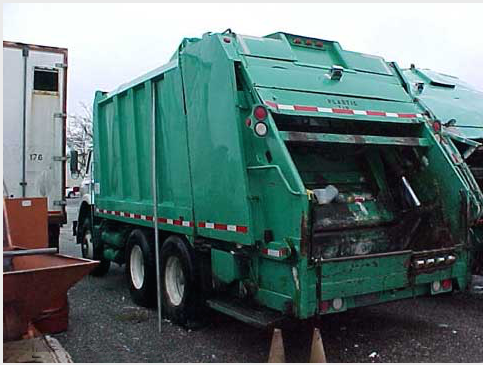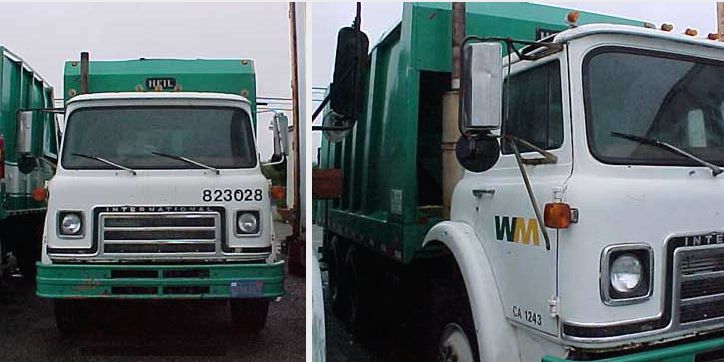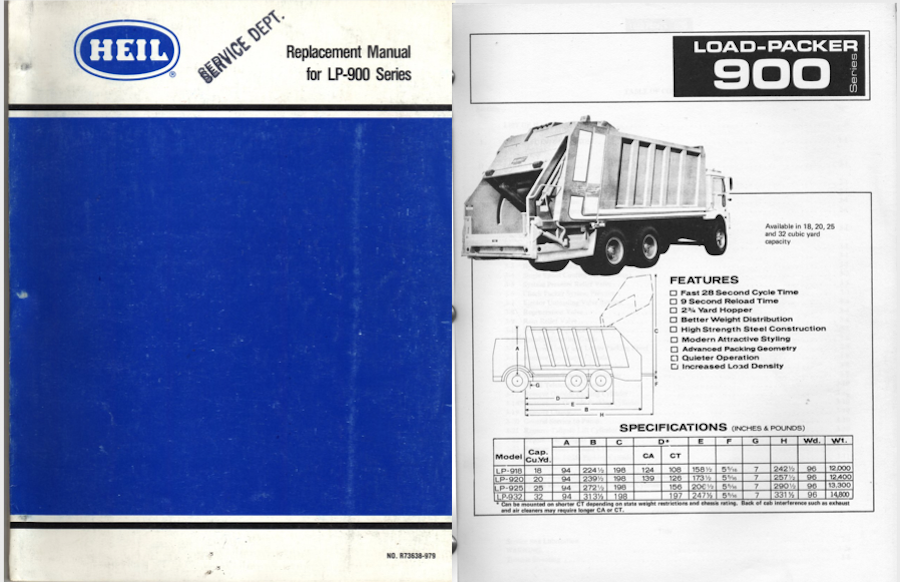 
Heil LP-900
The Demise of the Mark V

Three of the most popular high-compaction rear loaders of the 1970s: (L-R) Gar Wood Load-Packer 900, Leach 2-R Packmaster and Heil Mark V
Probably no one at the time could have foreseen the events which occurred at Heil in the late 1970s, undoubtedly one the strangest chapters in American refuse truck history. It involved not only Heil, but also Leach and Gar Wood, the top three rear-loader manufacturers at the time and the oldest names in the industry. Gar Wood had only a decade earlier been resurrected by Sargent Industries, which had bought the aging refuse truck line. Fresh engineering blood was brought in, resulting in the highly advanced Load-Packer 900. While it was certainly a very capable bulk packer, the 900 was specifically engineered to consume and efficiently compress large quantities of residential refuse. The entire structure was engineered to aid in the compaction process, with hydraulic pressure and the rolling and churning "Dyna-Action" occurring throughout the tailgate. It was one of the first rear loaders to use stress analysis in its design, and high-strength alloy steel to save weight. Sargent moved the Gar Wood operation from Detroit to Enterprise, Alabama, in a factory that built only refuse bodies.
The Leach 2-R Packmaster and Heil Colectomatic Mark V were rival packers born from the "brute force" school of high-compaction rear loader, with enormous tailgates and blades that could easily handle big containers, and even swallow whole automobiles if so desired. They also delivered fantastic residential payloads, while able to also collect bulk items in a single pass. The 2-R was clearly the undisputed champion, having invented the modern slide-sweep style rear loader as we know it when it arrived in 1959. It had taken a few years for haulers to fully realize what the 2-R was capable of, but it had quickly become legendary. Heil was relatively new to the bulk rear-load market, but their Mark V had proven itself a worthy rival to the big Leach, and had the advantage of a "trackless" packer blade. Even if Heil could not topple fortress Leach in the America, their sprawling international distribution network would more than make up the difference around the globe.
For their part, Leach Company was not going to stand idly by as their market share was being eaten away. The 2-R concept was perhaps the most important refuse truck design in history, and was unlike anything that came before it. The Leach slide-sweep method was soon adopted by Loadmaster (1964) and Pak-Mor (1967) which differed only from 2-R in the stroke and placement of their operating cylinders. However, Leach declined taking any legal action until Heil Company introduced the Mark V. In his book Good Riddance to Bad Rubbish, David Leach (without mentioning Heil or the Mark V) explained that his company had decided to go after their "biggest competitor". Heil certainly qualified, but the Mark V packer was far from being a copy of the 2-R. It had a two piece slide section, hinged mounting of the slide, swing links for control and an eccentric blade pivot, all of which were unique to Heil.
The exact nature of Leach's infringement claim is not known, but such cases can involve minutely technical issues. It may have related to the interaction of the upper and lower panels, a method never used in any refuse body prior the 2-R's invention, and common to most rear loaders by the 1970s. Whatever the claim, Leach actually prevailed in their suit, winning a settlement and royalties, in the event Heil decided to continue building the Mark V. While not a fatal blow to the company, it was nonetheless demoralizing, especially for the people of Solid Waste Systems Division which had seemingly done everything correct in the Mark V program. John Thomas was one of those people, having worked in sales management for Heil from 1968-1981, and recalls "...a dark day in Chattanooga when Joe Heil Jr. told us that Leach had won. Heil paid, and further, had to pay for use of the patent going forward."
"The Leach patent that cost Heil so dearly was interpreted by the court on a very technical issue. It caught everyone at Heil by surprise." adds Thomas. "I doubt that there were any enforceable patents in the UK that favored Leach." Thus, while the Mark V could continue being sold in Europe and Great Britain, it was finished in the American market. However, Heil could scarcely afford to be without a high-compaction rear loader for months (or years) while developing a replacement, which would have been prohibitive in cost. As fate would have it, Heil was about to be thrown a lifeline.
Relief for Heil's predicament came from Sargent Industries, the parent company of Gar Wood, then being managed by a former Heil executive named Ray Ohlgen (pioneer of the Heil Pulverizer). Despite having brought Gar Wood back from the brink with the excellent LP-900, Sargent was no longer interested in the manufacturing side of the refuse body business. They intended to shutter their Alabama facility, and license their successful patent portfolio (which included what was the LP-900, LP-1000 and FL-3000 front loader) around the world. With few other viable alternatives to replace to Mark V, Heil entered into an agreement to license the rights to build the former Gar Wood LP-900 rear loader on April 6, 1979.
This was a move not without some skepticism, since Gar Wood had been just as much a rival as Leach. Says Thomas, "I was one of the 'Doubting Thomases' on the staff, and was not convinced that buying the rights was a good idea. Boy, was I wrong! I had worked hard to help introduce, market, and promote the Mark V, and thus had a strong negative feeling about the LP-900." In Heil's favor were a proven design with iron-clad protection: Sargent Industries had multiple patents covering the LP-900, including the original, which was 41 pages long with no less than 79 technical claims. The former Gar Wood facilities at Enterprise, Alabama and Richmond, California were closed, and the tooling for their refuse bodies was being sold by June, 1979. Some of this equipment went to Germany, where manufacturing rights to the Sargent patents had been purchased by KSG/Edelhoff. The same jigs that once stamped out Gar Wood LP-900 panels in America thus wound up in Europe making the Europress LP-900.
The Mark V was abruptly discontinued for the North American market, as Heil quickly prepared to build the new model at Fort Payne. All-new tooling was created, with the most noticeable change being the body vertical reinforcing posts. Gar Wood had always built the 900 with forward-slanted posts, matching the angle of the tailgate rake, but Heil found that straight vertical posts worked better with their manufacturing process. It is the easiest way to differentiate a Gar Wood-built body from the ones made by Heil, which would thereafter be known as the Formula 5000. The many existing Gar Wood units would be serviced by Heil. Until the new plant could begin production, Heil acquired unsold Gar Wood LP-900 bodies and re-badged them under their own name. Having been built at Enterprise or Richmond, they were the slant-pillar types, and were sold as the Heil LP-900. These hybrids are among the rarest of all Heil (or Gar Wood) rear loaders. John Thomas notes the monumental task Heil had on their hands; "You can't imagine the amount of time and effort that went into the acquisition and subsequent marketing planning around [converting] the LP-900 into the Formula 5000. The longevity of the basic product design is without parallel in body designs. I sure wish we had known back during the discussions just how long the design would last."

Identifying Gar Wood and Heil-built bodies by their reinforcing pillars
Heil did not acquire the rights to Gar Wood FL-3000, having no need for a front loader. According to Fred Smith, they did however buy the rights to the LP-1000 residential rear loader, with its highly advanced curved-side body construction. Smith speculated that Heil bought the LP-1000 merely to keep it off the market, having no intention of actually putting it into production. This may well be the case, if not for packer mechanism, but for the futuristic body construction which is today almost universal. The LP-1000 was built in the UK and in Germany for a few years before being discontinued. In November, 1979, Heil would officially launch their Formula 5000 and applied the Formula name to most of their refuse product line. History would prove that Heil had made the right decision.
The continued existence of the mid-range Heil Mark IV after the Leach legal action poses an interesting question; since it was born of the same patent as the Mark V, why was it not also discontinued? One answer may be that the slight differences with its bigger brother were enough to avoid infringement on the Leach 2-R. A more plausible explanation may lie in the fact that the case did not go trial, but was settled between the parties. In settlement, Leach may have agreed not to include the smaller Mark IV, or accepted a smaller token royalty payment. Had the Mark IV been included in the case, it is far more likely that Heil would have merely replaced it with a low-compaction version of the Formula 5000 to avoid paying royalties. Indeed, the Mark IV enjoyed a decades-long life in the Heil family of rear loaders.
For pure academic fun, one could ponder this question; What if Leach had never challenged Heil in court over the Mark V? In that event, it is highly likely that the Mark V would have remained in U.S. production, as Heil would have had no pressing reason to acquire the patent rights to Sargent's LP-900. Since Sargent was eager to license their patents, perhaps E-Z Pack might have been in the market for the LP-900, especially in the days before the Goliath. Load-Master and Pak-Mor probably less so, being smaller companies, and the former having been in financial trouble during the 1970s. Dempster was committed to their revamped new Route King II. Smaller companies such as Wayne, New Way and Truxmore could likely not afford to buy the 900 rights without considerable risk and expense, especially given the depressed state of the U.S Economy in 1979.
In an unlikely but possible scenario, what if Sargent found no buyer for the LP-900 design rights in the USA. Would they have still ceased production of their rear loader? If so, this would have created a vacuum in the market for high-compaction rear loaders. Former Gar Wood customers might just as easily have switched to the 2-R Packmaster, or any of the others, adversely affecting the fortunes of other manufacturers, including Heil.
HYBRID: THE 1979 HEIL LP-900


Waste Management Inc. asset number 823028 is the only known example in photograhic existence of a Heil LP-900. These bodies were made at either Enterprise, Alabama or Richmond, California by Gar Wood Industries, and subsequently purchased by Heil and re-badged. Their role was as a stop-gap model, in between the end of Mark V production and start-up of Formula 5000 manufacturing at Fort Payne, Alabama.
This truck was part of an auction of California assets in 2006, and probably was originally owned by an independent hauler subsequently acquired by WMI. It is a 20-cubic yard model on an International Cargostar tandem chassis, and looks like it was in very good condition for being nearly thirty years old at the time. Its current whereabouts are unknown, and most likely it has been scrapped. This is unfortunate, since this would be one of the rarest refuse bodies around if it still exists.

Form number R73638, dated September 1979. This is an original copy of a Heil LP-900 parts manual which resides in the Classic Refuse Trucks Library. This Heil publication is an exact reprint of the Gar Wood LP-900 parts manual, except for a new cover, Heil service part numbers, and all references to Gar Wood eliminated. After acquiring manufacturing rights for this design from Sargent Industries, Heil took over the service and support for existing Gar Wood 900s, which was critical to maintaining and expanding the customer base.
|
REFERENCES
Decision on Petition 4378190 U.S. Department of Commerce, Patent and Trademark Office
(Document referencing Heil Company Licensing agreement with Sargent Industries)
Good Riddance to Bad Rubbish: The First 100 Years of Leach Company, Chapter 6, page 144
David C. Leach, The Leach Company, 1987
Solid Wastes Management/Refuse Removal Journal, April 1979, page 10
Heil Gets License to Make Gar Wood Rear Loader Bodies
Solid Wastes Management/Refuse Removal Journal, December 1979, page 48
Heil Introduces its Newly Adapted Rear Loader Packer to the Industry
America's Refuse Truck: The History of Gar Wood Industries, Chapter 18 Load-Packer 900
Eric Voytko, July 30, 2014 (Classic Refuse Trucks)
Interview: Fred T. Smith, inventor of the Gar Wood LP-900, March 25, 2003
E-mail correspondence: John Thomas, former Heil Company employee, August, 2009
|



5/29/17
© 2017
All Rights Reserved
Photos from factory brochures/advertisements except as noted
Logos shown are the trademarks of respective manufacturers
|
| |